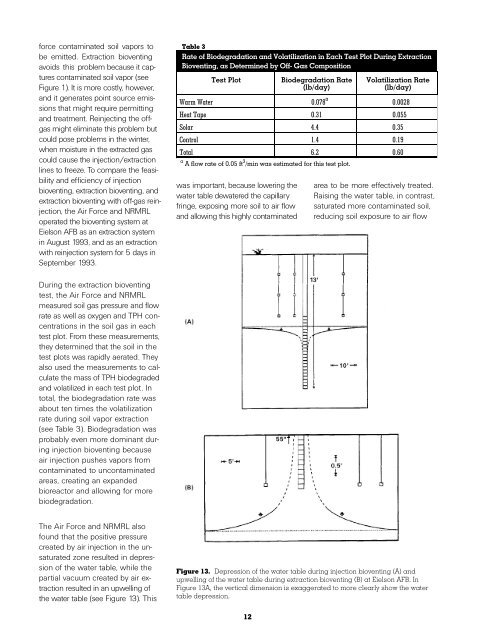Bioremediation Field Evaluation Eielson Air Force Base, Alaska
Bioremediation Field Evaluation Eielson Air Force Base, Alaska
Bioremediation Field Evaluation Eielson Air Force Base, Alaska
You also want an ePaper? Increase the reach of your titles
YUMPU automatically turns print PDFs into web optimized ePapers that Google loves.
force contaminated soil vapors to<br />
be emitted. Extraction bioventing<br />
avoids this problem because it captures<br />
contaminated soil vapor (see<br />
Figure 1). It is more costly, however,<br />
and it generates point source emissions<br />
that might require permitting<br />
and treatment. Reinjecting the offgas<br />
might eliminate this problem but<br />
could pose problems in the winter,<br />
when moisture in the extracted gas<br />
could cause the injection/extraction<br />
lines to freeze. To compare the feasibility<br />
and efficiency of injection<br />
bioventing, extraction bioventing, and<br />
extraction bioventing with off-gas reinjection,<br />
the <strong>Air</strong> <strong>Force</strong> and NRMRL<br />
operated the bioventing system at<br />
<strong>Eielson</strong> AFB as an extraction system<br />
in August 1993, and as an extraction<br />
with reinjection system for 5 days in<br />
September 1993.<br />
During the extraction bioventing<br />
test, the <strong>Air</strong> <strong>Force</strong> and NRMRL<br />
measured soil gas pressure and flow<br />
rate as well as oxygen and TPH concentrations<br />
in the soil gas in each<br />
test plot. From these measurements,<br />
they determined that the soil in the<br />
test plots was rapidly aerated. They<br />
also used the measurements to calculate<br />
the mass of TPH biodegraded<br />
and volatilized in each test plot. In<br />
total, the biodegradation rate was<br />
about ten times the volatilization<br />
rate during soil vapor extraction<br />
(see Table 3). Biodegradation was<br />
probably even more dominant during<br />
injection bioventing because<br />
air injection pushes vapors from<br />
contaminated to uncontaminated<br />
areas, creating an expanded<br />
bioreactor and allowing for more<br />
biodegradation.<br />
The <strong>Air</strong> <strong>Force</strong> and NRMRL also<br />
found that the positive pressure<br />
created by air injection in the unsaturated<br />
zone resulted in depression<br />
of the water table, while the<br />
partial vacuum created by air extraction<br />
resulted in an upwelling of<br />
the water table (see Figure 13). This<br />
Table 3<br />
Rate of Biodegradation and Volatilization in Each Test Plot During Extraction<br />
Bioventing, as Determined by Off- Gas Composition<br />
Test Plot Biodegradation Rate<br />
(lb/day)<br />
Warm Water 0.078 a<br />
was important, because lowering the<br />
water table dewatered the capillary<br />
fringe, exposing more soil to air flow<br />
and allowing this highly contaminated<br />
Volatilization Rate<br />
(lb/day)<br />
Heat Tape 0.31<br />
0.0028<br />
0.055<br />
Solar 4.4 0.35<br />
Control 1.4 0.19<br />
Total 6.2 0.60<br />
a 3<br />
A flow rate of 0.05 ft /min was estimated for this test plot.<br />
area to be more effectively treated.<br />
Raising the water table, in contrast,<br />
saturated more contaminated soil,<br />
reducing soil exposure to air flow<br />
Figure 13. Depression of the water table during injection bioventing (A) and<br />
upwelling of the water table during extraction bioventing (B) at <strong>Eielson</strong> AFB. In<br />
Figure 13A, the vertical dimension is exaggerated to more clearly show the water<br />
table depression.<br />
12















